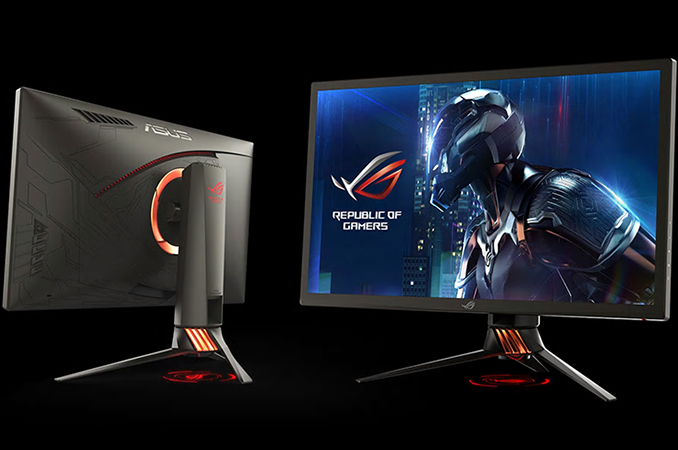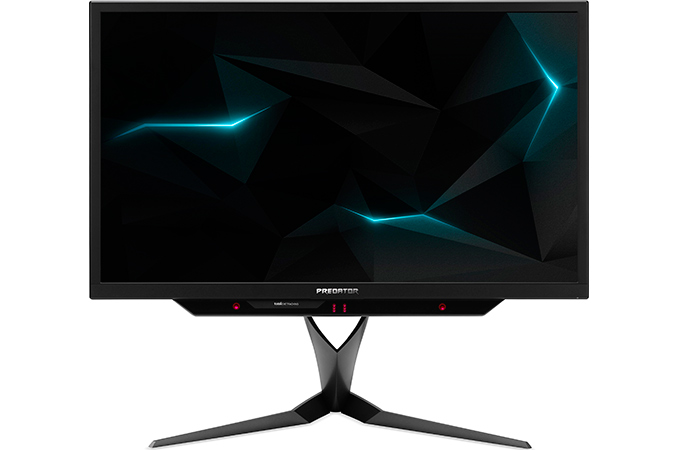NVIDIA Expects 4K 144 Hz G-Sync HDR Displays to Launch in April
by Anton Shilov on March 21, 2018 6:35 PM EST- Posted in
- Monitors
- Displays
- Acer
- Asus
- NVIDIA
- Predator X27
- ROG Swift PG27UQ
- G-Sync HDR

Acer and ASUS unveiled their prototype 27” 4K 144 Hz displays, featuring NVIDIA’s G-Sync HDR technology, at last year’s CES, with promises to release them sometime later in 2017. Both monitors relied on a reference design developed by NVIDIA and had similar specifications, albeit with some minor differences. Eventually, both companies had to delay commercial launches of their new products to 2018, missing the important holiday sales season. This week at GDC, NVIDIA has stated that it is confident that the G-Sync HDR-compatible displays will hit the market this April.
Both the Acer Predator X27 and the ASUS ROG Swift PG27UQ are implementations of NVIDIA’s reference design for G-Sync HDR displays: they offer a 3840×2160 resolution, a 144 Hz refresh rate, a 1000-nits brightness, a direct LED backlighting system with 384 zones, and feature a quantum dot film to enable HDR10 and coverage of the DCI-P3 color gamut. The monitors announced last year were to be based on AU Optronics’ M270QAN02.2 AHVA panel, which was the only one to support the combination of features that NVIDIA wanted for G-Sync HDR displays.
Neither Acer, nor ASUS, disclosed the reasons why they had to delay their ultra-premium gaming monitors from late 2017 to 2018, but given a rather unique feature-set of both displays, a lot of possibilities come to mind: starting from a panel delay by AUO to reference design changes by NVIDIA.
At GDC, NVIDIA has said that G-Sync HDR-supporting displays will finally ship in Q1, but noted that by Q1 it means its fiscal quarter, not calendar quarter. NVIDIA’s Q1 FY2019 (2019 because NV's fiscal year is one year ahead) ends on April 29, 2018, so it is logical to assume that the monitors will ship next month. What remains to be seen is the pricing as well as the final set of features and technologies.
Related Reading
- Acer and ASUS Delay Their 4K 144 Hz G-Sync HDR Displays to 2018
- ASUS Demonstrates ROG Swift PG27UQ: 4K, 144 Hz, HDR, DCI-P3 and G-Sync
- Acer Announces Predator X27 Monitor: 4K@144 Hz with DCI-P3, HDR10, & G-Sync
- Samsung Announces First Freesync 2 Monitors: CHG70 & CHG90 - Quantum Dots, Up to 49”, 144 Hz, DCI-P3
Source: NVIDIA











61 Comments
View All Comments
Ryan Smith - Thursday, March 22, 2018 - link
DSC is not necessary if you use 4:2:2. That was what NVIDIA decided upon to get the bandwidth figures to work out.willis936 - Thursday, March 22, 2018 - link
I'll be interested to learn if the monitor switches to 4:4:4 if the monitor is used in a mode that doesn't require more than 32.4 Gbos.Ryan Smith - Thursday, March 22, 2018 - link
I can't imagine a scenario where they're stuck in 4:2:2. The lower chroma subsampling is for bandwidth reasons; the panel would be full 30 bit color regardless.bug77 - Thursday, March 22, 2018 - link
No consumer card does 10bpp anyway. So there's that.Ryan Smith - Thursday, March 22, 2018 - link
All current generation consumer cards do 10bpp. NVIDIA just restricts 10bpp support under OpenGL to their pro cards.Hurr Durr - Thursday, March 22, 2018 - link
>sufferYou can`t even see the difference in motion, (((sufferer))).
willis936 - Thursday, March 22, 2018 - link
Looks like someone doesn't play warframe or any other high motion game.Hurr Durr - Thursday, March 22, 2018 - link
>warframeThey actually deserve it then.
zodiacfml - Thursday, March 22, 2018 - link
Since it is late, it will be interesting to see the position of these monitors vs. what they call the Big Format Gaming Displays (BFGDs).I already bought a 43" 4K TV which is excellent as a non-gaming monitor despite its low cost.
halcyon - Thursday, March 22, 2018 - link
Finally, I hope these launch times, esp. for the 32" versions finally stick. It's been a series of postponement after postponement.And the Asus 32" HDR 4K FALD monitor is NOT performing up to par (even for a ProArt graphics/video professional display), so we do need the competition.